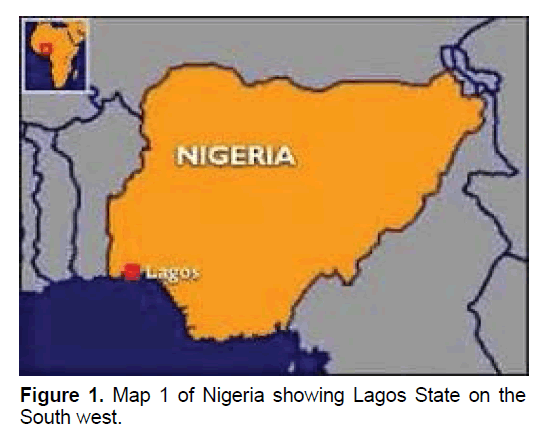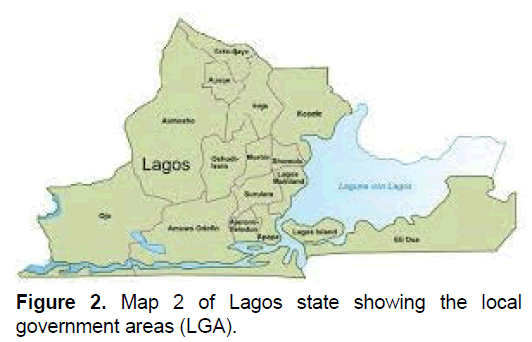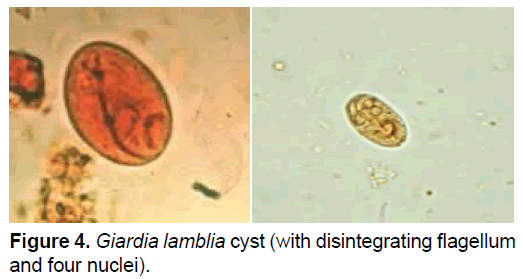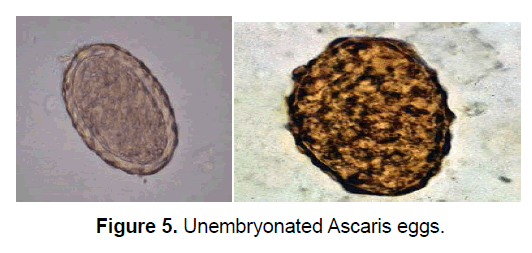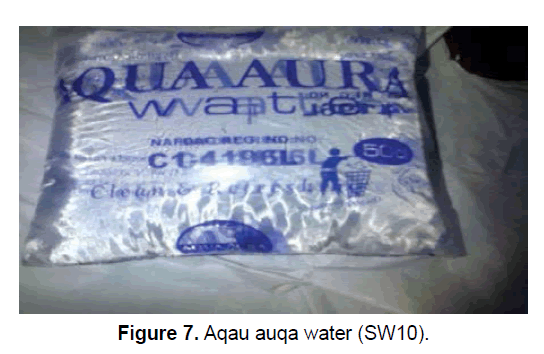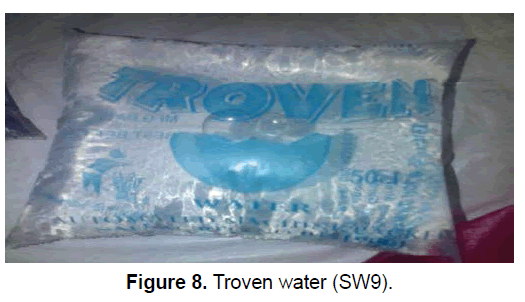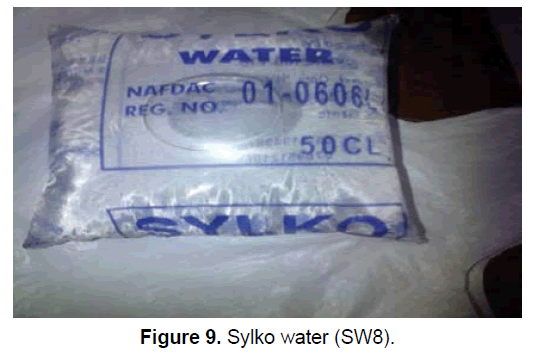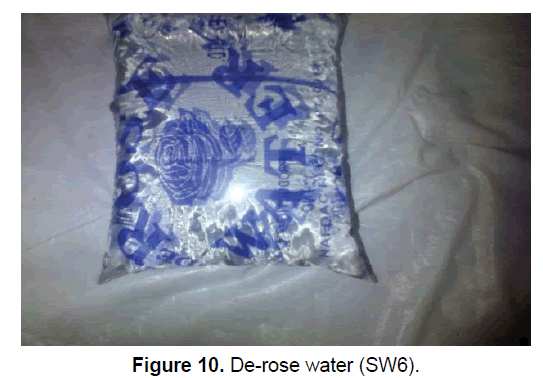Parasitological Evaluation of Sachet Drinking Water in Areas of Lagos State, Nigeria
Okwa Omolade O, Gbadamosi Zanaib O
Department of Zoology and Environmental Biology, Parasitology Unit, Faculty of Science, Lagos State University, Lagos, Nigeria.
Received date: March 27, 2017; Accepted date: April 24, 2017; Published date: May 01, 2017
Citation: Omolade OO, Zanaib GO. Parasitological Evaluation of Sachet Drinking Water in Areas of Lagos State, Nigeria. Electronic J Biol, 13:2
Abstract
Sachet water (Pure water) is a major source of drinking water for low and medium class Nigerians. Evaluation of sachet water for the presence of intestinal cysts and eggs of parasites was carried out in Lagos State, Nigeria. This was in order to determine the safety and stability of such water for human consumption. Fifty samples of packaged water were purchased randomly from hawkers within twenty local government areas of Lagos. Samples were observed macroscopically for taste, colour and odour and pH tested according to the World health organization (W.H.O) Standard. 10 ml of each sample were taken within and outside by rinsing each sachet and centrifuged at 2500 rpm per min. Sediments were stained with Lugol’s iodine on a glass slide and examined microscopically at x40 and x100 under an Olympus binocular microscope. All the tested samples met the W.H.O standard of being colourless, odourless and tasteless and with an average pH of 7.42. Out of the fifty samples, 16% had impurities only, 24% had parasites and impurities and 18% had parasites only, hence 58% was not fit for human consumption of which 42% were contaminated with cysts and eggs of intestinal parasites and out of these 28% was found outside of the sachets. Cysts recovered were that of Entamoeba histolytica (10%) and Giardia lamblia (12%) and eggs of Ascaris lunbricoides (16%) and Necator americanus (Hookworm) (4%). This study indicated that some pure water is not really “pure”. Improper handling of sachet water by hawkers, play a significant role in transmission of water borne parasitic infections. Health education for handlers and hawkers of sachet water is advocated. Regulating bodies like National Agency for Food and Drugs administration and Control (NAFDAC), Nigerian Ministry of health and the Standard organization of Nigeria (SON), need to effectively monitor and get producers of sachet water to comply strictly with their guidelines.
Keywords
Intestinal parasites; Eggs; Cyst; Sachet water; Lagos State; Nigeria.
1. Introduction
Water is one of the indispensable resources for the continued existence of all living things including man hence adequate supply of fresh and clean drinking water is a basic need for all human beings. Water is defined as a liquid substance that is colorless, odorless, clear and capable of existing in a liquid, solid or gaseous phase. It is a basic necessity of life, second to air, because it serves as a source of nourishment to man, animal, microorganisms and even plants [1]. Water is a unique solution, it makes up about 80 percent of the cell’s composition. Water is very distinct from any other way of quenching taste because of its chemical composition. Water has been part of nature from time immemorial and can sometimes be contaminated in its natural environment [2].
Nigeria is located in coastal West Africa where water is abundant, yet most of the population lacks adequate and safe drinking water. As a result, individuals who can afford water now sink boreholes and sell water, some without any major form of treatment, to the ever growing population. In Nigeria, water is produced into many products such as sachet water popularly known as “pure water”. Sachet water is commercially treated water, manufactured, packaged and distributed for sale in sealed polythene containers for human consumption. The production of sachet water in Nigeria started in the late 90s and today the advancement in scientific technology has made sachet water production one of the fastest growing industries in the country [3]. Many individuals and corporate bodies in Nigeria now engage in packaging water in polythene sachets of about 50-60 cl which they sell to the public. Thus, drinking water is commercially available in such easy to open sachets. The production, marketing and consumption of sachet water have increased tremendously. There are now several brands of this sachet water marketed in Nigeria. The majority of consumers tend to be more concerned with the appearance and taste of water than the invisible loads of potentially harmful micro-organisms as well as other contaminants that may be present in the water [4].
The continuous increase in the sale and indiscriminate consumption of sachet water in Nigeria is of public health significance, as the prevalence of water related diseases in developing countries is determined by the quality of their drinking water [5]. Sachet water is seen to be a good supplement to other types of packaged water and can be bought at cheaper price. It is a source of drinking water for low and medium class Nigerians [6].
Parasites are organisms that live in a close relationship with other organism (hosts) and are capable of causing harm to their host. Their routes of transmission are of great importance in the health of many populations in developing countries, where the frequency of infection is a general indication of local hygiene and environmental sanitation levels [7].
Parasitic infections which have direct life cycle and do not need an intermediate host to infect a new host are acquired through direct ingestion of infected eggs or cysts is intimately linked with the level of personal hygiene and sanitation in the community. Infections can also be acquired through contaminated food or drinks. The resistance capacity of intestinal parasites is a feature of profound influence on the epidemiology. For example, eggs of Ascaris can remain viable for up to six years in the soil [8].
Intestinal parasites cause significant morbidity and mortality throughout the world, particularly in developing countries. When water becomes contaminated by parasites, it can cause varieties of illness, pain, disability and even death. Globally, millions of people suffer from intestinal parasitic diseases such as Ascariasis (55 million), Trichuriasis (34 million), Hookworm (38 million), Amoebiasis (10 million) and Giardiasis (1.5 million) which can be water borne. These are neglected tropical diseases of which Nigeria has the greatest number of victims in Africa [9].
In recent years, lots of research has been carried out in various parts of the country to determine the purity of sachet water, and most of the results point towards the same conclusion; that our so called “pure water” may not be completely safe for drinking. The results of the studies on sachet water to determine purity and safety have almost always churned up evidence of microbial and in some cases chemical contaminants [10].
Past studies on bacteriological purity of sachet water in Nigeria has been conducted by several researchers such as Mgbakor et al. [4] and Mustapha et al. [11], in Owerri, Ibadan and Lagos. The Sachet waters were reported to contain bacteria such as Bacillus sp., Pseudomonas sp., Klebsiella sp., Streptococcus sp., Serratia sp., Chromobacterium sp., Proteus mirabilis and oocysts of Cryptosporidia sp. (a protozoan parasite).
Another study by Ekwunife et al. [12], to ascertain the parasites associated with sachet drinking water in Awka, Anambra State, South-east Nigeria indicated that all the tested water samples met World Health Organization (W.H.O) recommended standard, of being colorless, tasteless and odorless with average pH of 6.93. Some parasites were found on the surface of the sachets. Identified parasites included cysts of Ascaris lumbricodes (5.6%), Entamoeba histolytica (4.6%), Hookworm (2.8%), Trichuris trichuria (2.8%) and Giardia lamblia cysts (1.9%).
Most other studies have reported a compromise of water quality in one way or the other [12-15]. Egwari et al. [3] carried out bacteriological investigation on sachet water in Lagos, Nigeria. This study is however the first of its kind of parasitological evaluation of sachet water in Lagos, Nigeria where sachet water is highly and indiscriminately consumed.
The general objective of this present study is to determine in Lagos State, Nigeria the types of parasites associated with sachet water (pure water) and determine whether it is really” pure”.
The specific objectives of this present study are:
A. To carry out macroscopic examination of sampled sachet water by ascertaining the physiochemical parameters, e.g. taste, colour and odour and PH according to WHO (2016) recommended standard [16].
B. To determine by microscopy which brand of sachet water has parasitic contamination and impurities and the geographical area of Lagos where they were obtained.
2. Materials and Methods
2.1 Study area
The study was conducted in Lagos State, the former capital of Nigeria and still an economic and commercial nerve centre of the Nation. It is located in the southwestern geopolitical zone of Nigeria. The smallest in area of Nigeria's 36 States, but containing the nation's largest urban area.
With 20 Local Government Areas (LGA), the actual population is about 17,552,940. On the North and East it is bounded by Ogun State. In the West it shares boundaries with the Republic of Benin. Behind its southern borders lies the Atlantic Ocean. It is a State of aquatic splendor as 22% of its 3,577 km2 are lagoons and creeks (Figures 1 and 2).
2.2 Collection of sachet water
A total sample of 50 different brands of sachet water was purchased randomly from hawkers and vendors within 20 L.G.A of Lagos State. They all had the National Agency for Food and drug Administration and Control (NAFDAC) certification number. They were conveyed to the Zoology and Environmental Biology laboratory of the Lagos State University (LASU). The 50 sachet water (SW) was given a code (SW1- 50) and the area of collection and local government indicated (Table 1). They were then subjected to Macroscopic and parasitological examinations to determine the presence of parasitic cysts and eggs.
2.3 Materials and reagents
Materials used were Slides, cover slips, applicator sticks, sterile bottles, hand gloves, Olympus light microscope (binocular), syringe (10 ml), centrifuge tubes, centrifuge machine, paper tape, 0.85% normal saline, 5% lugol’s iodine, dropping pipette and beakers, pH meter and sample bottles.
2.4 Preparation of reagents
For Normal saline, 0.85% of sodium chloride was weighed and dissolved in 100 ml of distilled water. The solution was sterilized with autoclave at 121 for 15 min and after cooling it was stored at room temperature. For lugol’s iodine, the solution was prepared by dissolving 10 g of potassium iodine and 5 g of iodine crystals in 100 ml of distilled water and shaken vigorously. It was stored in a dark bottle away from sunlight.
2.5 Laboratory examination
Macroscopic examination: Macroscopic analysis which includes the colour, odour, taste and pH of the samples was carried out according to WHO Standard (WHO 2016).
| Code | Sachet Water Sampled | Areas of Collection/LGA |
|---|---|---|
| SW1 | Hope Diego | Mowo (Badagry) |
| SW2 | De-Robin | Lasu (Ojo) |
| SW3 | Arise/Shine | Agbara(Badagry) |
| SW4 | Total givers | Okoko (Okoko) |
| SW5 | De-Rose | Iba(Ojo) |
| SW6 | Clison Water | Ojo(Ojo) |
| SW7 | Cool | Navy town (Amuwo-odofin) |
| SW8 | Sylko Water | Festac Town (Amuwo-odofin) |
| SW9 | Troven | Alausa(Ikeja) |
| SW10 | Aqua Auqa | Idimu (Alimosho) |
| SW11 | Nnek | Ishasi (ojo) |
| SW12 | De-Robin | Ojo (Ojo) |
| SW13 | Kofo water | Epe (Epe) |
| SW14 | Ebeks Water | Ikorodu (Ikorodu) |
| SW15 | Choice Water | Ikorodu (Ikorodu) |
| SW16 | Total royal | Shibiri (Ojo) |
| SW17 | Magjoy | Surulere (Sururelere) |
| SW18 | Glorious Day | Ishasi (Ojo) |
| SW19 | Owo-iya | Agege (Agege) |
| SW20 | Moko | Agangbadi (Ojo) |
| SW21 | Kotek | Ketu (Kosofe) |
| SW22 | Kins Water | Agege (Agege) |
| SW23 | Sunrise | Yaba (Shomolu |
| SW24 | Achievers | Mushin (Isolo) |
| SW25 | Top waters | Lekki (Eti-Osa) |
| SW26 | Christ kingdom | Mile 2 (Amuwo-Odofin) |
| SW27 | Lizbeth Water | Igbogbo (Ikorodu) |
| SW28 | Joesam Water | Ebute-Metta (Lagos Main-land) |
| SW29 | Netcom Water | Shomolu (Shomolu) |
| SW30 | Dee-Ozone | Bariga (Shomolu) |
| SW31 | Dims Water | Surulere (Surulere) |
| SW32 | Govic Water | Orile (Ajelodun Ifelodun) |
| SW33 | RunnelÃÆââ¬Å¡ÃâàWater | Epe (Epe) |
| SW34 | Zeal Water | Alimosho (Alimosho) |
| SW35 | Markpetal Water | Ikotun (Alimosho) |
| SW36 | AA water | Egbeda (Alimosho) |
| SW37 | Vicmide Water | Agege (Ikeja) |
| SW38 | Sunar Water | Oshodi (Oshodi Isolo) |
| SW39 | Haven Water | Apapa ( Lagos Lsland) |
| SW40 | Choozy | Ojota (Kosofe) |
| SW41 | Sony Water | Alimosho (Alimosho) |
| SW42 | Hasfat Water | Ikeja (Ikeja) |
| SW43 | Vatten Water | Festac (Amuwo-odofin) |
| SW44 | Sanctuary Water | Akowonjo (Alimosho) |
| SW45 | Memo Water | Ogba (Ifako-Ijaiye) |
| SW46 | Vatican Water | Surulere (Surulere) |
| SW47 | Royal Choice | Ogba (Ifako-ijaye) |
| SW48 | Hay-K Water | Ebute- Metta (Lagos Main-land) |
| SW49 | Mr barry Water | Amukoko (Ajeromi ifelodun) |
| SW50 | Lajan Water | Badagry (Badagry) |
Table 1. The brand of the 50 sachet water sampled and their codes from 20 LGA.
Parasitological examination: Each sachet water went through parasitological examination. Both the polythene sachet water and its content were examined microscopically. 10 ml of each sample was vigorously shaken and dispensed into ten 15 ml sterile centrifuge tubes. The test tubes and its content were centrifuged at 2500 rpm. The resultant sediment was stirred with a clean applicator stick and a drop was placed on a clean grease free slide mixed with a drop of lugol’s iodine solution. The mixture was covered with a cover slip and examined under an Olympus binocular microscope using x40 and x100 objective lenses with oil immersion.
Identification of intestinal cysts and eggs: Only viable eggs and cysts were identified. Entamoeba histolytica cysts were identified by a four nuclei ovoid cyst of 10-15 μm containing rod shaped chromatoid bodies. The G. lamblia cyst is eggshaped and measures 8-14 μm by 7-10 μm with four nuclei and disintegrating flagella. The eggs of Ascaris lumbricoides were unembryonated, oval with characteristics warty or mammilated appearance and 50 by 40 μm. They were brownish yellow and thick shelled with three layers. The eggs of Necator americanus (hookworm) were embryonated and characterized by roundish, thin, transparent hyaline shells with blastomeres of between 2-8 cells (60 μm by 40 m) (Figures 3-6).
2.6 Statistical analysis
The percentage of sachet water having no impurities and no parasites, only parasites, parasites and impurities and only impurities were calculated and analyzed in forms of tables.
3. Results
Four of the sampled sachet water with their codes (Figures 7-10 and Table 1).
3.1. Macroscopic examination of sachet water
All the 50 sampled sachet water where found to be tasteless, colorless, odorless and also met up with the WHO Standard of pH. They had varying pH (6.53-8.40) with and average pH of 7.42 (Table 2).
3.2 Parasitological examination of sachet water
Microscopic examination revealed that 21(42%) of the 50 sampled sachet water where found to be pure both within and outside and they included: (SW6, SW9, SW12, SW14, SW16, SW17, SW19. SW23, SW25, SW27, SW30, SW31, SW33, SW34, SW37, SW38, SW40, SW43, SW46, SW47, SW50). On the contrary, 8 (16%) of the 50 sachet water where found to be contaminated with only impurities: 7 (14%) outside and 1 (2%) within (Table 3). Furthermore, 12 (24%) of the 50 sachet water were found to be contaminated with both parasitic cysts and eggs with impurities, more were detected outside the sachet water (Table 4). However, only 9 (18%) of the 50 sachet water were contaminated with only parasitic cysts and eggs with 2 (4%) within and 7 (14%) outside the sachet waters.
| Sample Sachet Water | pH | Sample Sachet Water | pH | Sample Sachet Water | pH |
|---|---|---|---|---|---|
| SW1 | 8.25 | SW20 | 7.20 | SW39 | 6.70 |
| SW2 | 7.52 | SW21 | 6.80 | SW40 | 8.34 |
| SW3 | 7.06 | SW22 | 8.30 | SW41 | 7.02 |
| SW4 | 6.89 | SW23 | 7.50 | SW42 | 7.43 |
| SW5 | 6.53 | SW24 | 6.75 | SW43 | 6.95 |
| SW6 | 7.40 | SW25 | 7.02 | SW44 | 7.30 |
| SW7 | 7.20 | SW26 | 8.29 | SW45 | 7.57 |
| SW8 | 8.20 | SW27 | 7.20 | SW46 | 6.90 |
| SW9 | 8.40 | SW28 | 6.81 | SW47 | 7.81 |
| SW10 | 7.20 | SW29 | 8.25 | SW48 | 8.40 |
| SW11 | 6.90 | SW30 | 6.90 | SW49 | 8.10 |
| SW12 | 7.50 | SW31 | 7.00 | SW50 | 7.20 |
| SW13 | 7.00 | SW32 | 6.42 | Average pH | 7.42 |
| SW14 | 7.50 | SW33 | 8.02 | ||
| SW15 | 8.10 | SW34 | 7.50 | ||
| SW16 | 7.65 | SW35 | 6.90 | ||
| SW17 | 7.20 | SW36 | 8.30 | ||
| SW18 | 8.20 | SW37 | 6.54 | ||
| SW19 | 7.50 | SW38 | 7.20 | ||
Table 2. The pH of the 50 sachet water collected from 20 L.G.A of Lagos State, Nigeria.
Overall, 29 (58%) of the sachet water are unfit for human consumption with 21 (42%) with parasitic cyst and eggs and 14 (28%) of these parasitic cysts and eggs were found mostly on the outside of the sachet water (Table 5).
Eggs of parasites recovered were Ascaris lumbricoides (16%) and Necator americanus (Hookworm) (4%) and cysts of Giardia lamblia (12%) and Entamoeba histolytica (10%) which accounts for 42% of the 50 sampled sachet water (Table 6).
| Code of Sachet Water | Impurities Within | Impurities Outside |
|---|---|---|
| SW2 | Nil | Yes |
| SW10 | Yes | Nil |
| SW11 | Nil | Yes |
| SW15 | Nil | Yes |
| SW21 | Nil | Yes |
| SW32 | Nil | Yes |
| SW41 | Nil | Yes |
| SW49 | Nil | Yes |
| Total: ÃÆââ¬Å¡ÃâàÃÆââ¬Å¡ÃâàÃÆââ¬Å¡ÃâàÃÆââ¬Å¡ÃâàÃÆââ¬Å¡ÃâàÃÆââ¬Å¡ÃâàÃÆââ¬Å¡ÃâàÃÆââ¬Å¡Ãâà8 (16%) | 1 (2%) | 7 (14%) |
Table 3. The eight (8) Sachet water (SW) with only impurities.
| Code of Sachet Water | Parasites Within | Impurities Within | Parasites Outside | Impurities Outside | |
|---|---|---|---|---|---|
| SW3 | Nil | Yes | Egg of A. lumbricoides. | Nil | |
| SW5 | Nil | Yes | Egg of A. lumbricoides. | Nil | |
| SW7 | Nil | Yes | Egg of A. lumbricoides. | Nil | |
| SW13 | Nil | Yes | Cyst of G. lamblia | Nil | |
| SW18 | Egg of N. americanus | Nil | Nil | Yes | |
| SW22 | Nil | Yes | Cyst of G. lamblia | Nil | |
| SW24 | Nil | Yes | Egg of A. lumbricoides | Nil | |
| SW29 | Cyst of E. histolytica | Nil | Nil | Yes | |
| SW36 | Egg of A. lumbricoides | Nil | Nil | Yes | |
| SW39 | Egg of A. lumbricoides | Yes | ÃÆââ¬Å¡ÃâàNil | Nil | |
| SW42 | Nil | Yes | Cyst of E. histolytica | Yes | |
| SW44 | Cyst of G. lamblia | Nil | Nil | Yes | |
| Total: 12 (24%) | 5 (10%) | 8 (16%) | 7 (14%) | 5 (10%) | |
Table 4. The twelve (12) sachet water (SW) with both parasitic organisms and impurities.
| Code of Sachet Water | Parasite Within | Parasite Outside |
|---|---|---|
| SW1 | Nil | Egg of A. lumbricoides |
| SW4 | Nil | Cyst of G. lamblia |
| SW8 | Nil | Cyst of G. lamblia |
| SW20 | Cyst of E. histolytica | ÃÆââ¬Å¡ÃâàNil |
| SW26 | Cyst of E. histolytica | Nil |
| SW28 | Nil | Egg of N. americanus |
| SW35 | Nil | Cyst of G. lamblia |
| SW45 | Nil | Egg of A. lumbricoides |
| SW48 | Nil | Cyst of E. histolytica |
| Total:ÃÆââ¬Å¡ÃâàÃÆââ¬Å¡ÃâàÃÆââ¬Å¡ÃâàÃÆââ¬Å¡ÃâàÃÆââ¬Å¡ÃâàÃÆââ¬Å¡ÃâàÃÆââ¬Å¡Ãâà9 (18%) | 2 (4%) | 7 (14%) |
Table 5. The nine (9) sachet water (SW) that has only parasitic organisms.
| Intestinal Cyst or Eggs | ÃÆââ¬Å¡ÃâàSW with only Parasites Within | ÃÆââ¬Å¡ÃâàSW with only Parasites Outside | ÃÆââ¬Å¡ÃâàSW with Parasites and Impurities Within. | ÃÆââ¬Å¡ÃâàSW with Parasites and Impurities Outside. | Total |
|---|---|---|---|---|---|
| A. lumbricoides | Nil | 2 (4%) | 2 (4%) | 4 (8%) | 8 (16%) |
| N. americanus | Nil | 1 (2%) | 1 (2%) | Nil | 2 (4%) |
| E. histolytica | 2 (4%) | 1 (2%) | 1 (2%) | 1 (2%) | 5 (10%) |
| G. lamblia | Nil | 3 (6%) | 1 (2%) | 2 (4%) | 6 (12%) |
| Total | 2 (4%) | 7(14%) | 5 (10%) | 7 (14%) | 21 (42%) |
Table 6. Prevalence of intestinal parasitic cyst and eggs associated with the 50 sachet water (SW).
4. Discussion
Water is an essential resource for life. Water is taken by everyone, every day because people need drinking water to survive. According to Kulshershtha [17], one of the major and critical problems in most developing countries today is the provision of an adequate and safe drinking water to its populace. Access to safe drinking water is a vital agent for living of humans.
Hence, this study was carried out to evaluate the parasitological quality of some sachets water in Lagos state, Nigeria. All the samples in this study met up with the WHO (2016) standards of been colourless, odourless and tasteless with average pH of 7.42. This research has shown that Ascaris lumbricoides eggs were most prevalent in the study area followed by cysts of Giardia lamblia and Entamoeba histolytica and eggs of Necator americanus (Hookworm). The result of this work shows that some sachet water (pure water) are not really” pure”.
Even local sources of drinking water from which some sachet water are obtained are contaminated [18]. A study carried out in Ebonyi state, Nigeria by Chollom et al. [19] to evaluate the parasitic contamination of local sources of drinking water, recorded high parasitic contamination of the different water sources in the rural villages. Similarly, more than half of the number of streams investigated was infested with parasites. This could be as a result of feacal and sewage contamination of the river during rainy season. Water samples from boreholes and rainwater had low level of infestation respectively. This is because boreholes operated a closed system while water harvested from rains is usually covered.
Unfortunately, contamination of water can be due to many reasons which include: feacal contamination, poor sewage disposal and poor personal hygiene, lack of basic sanitation, bad storage facilities and poor treatment of water. Apart from environmental contaminants, improper storage and handling by vendors also poses a serious threat to the health of the ignorant consumers.
According to Denloye [20], It is a known fact that no single method of purification can eliminate 100% contaminants from drinking water, However, water can be and should be made safe for consumption within acceptable limits.
The potential health danger of contaminated sachet water is obvious from this study as it has confirmed that majority of the contamination outside the sachet water might be due to improper handling and storage by hawkers and within by improper treatment and packaging by the manufacturers. Most of the times, these hawkers use their dirty, sweaty hands to pick up the sachet water and sell to consumers therefore they act as the major vehicle of transmission of intestinal parasites [13].
Ekwunife et al. [12] in Akwa, South-eastern Nigeria, ascertained the parasites associate with sachet drinking water. The samples collected met the WHO recommended standard. That finding corroborated the result of this work. In that study, no parasites were found within the sachets but outside the sachets, which is partly in contrast with this work because parasites were found within some sachet water in this present study. That study also reported that the sachet water purchased from hawkers had the highest number of parasites. Identified parasites detected were similar with that of this present study except the eggs of Trichruris trichuria which were not detected in this present study.
NAFDAC is an agency of the Nigerian government charged with regulating the manufacture and sale of food, drugs and cosmetics in the country and by extension, has oversight of the packaged water industry. Drinking water that is safe and aesthetically acceptable is a matter of high priority to NAFDAC and is expected to meet the Nigerian Industrial Standard. Furthermore, drinking water that is fit for human consumption is expected to meet the WHO standard and be free from physical and chemical substances and microorganisms in an amount that can be hazardous to health [14]. On the contrary, consumption of sachet water in Nigeria is on the increase irrespective of whether they have NAFDAC Certification or not or meet the WHO standard.
NAFDAC is mandated to enforce compliance with internationally defined drinking water guidelines, but regulation of the packaged water industry aimed at good quality assurance has remained a challenge to the agency [15]. However, despite the strong effort by NAFDAC in the regulation and quality assessment of sachet water, there are a growing number of reported public illnesses after drinking sachet water. There are a number of reported cases of typhoid, diarrhea and other water borne diseases arising from consumption of sachet water [21].
It is imperative that the regulatory bodies like NAFDAC should consistently and periodically monitor the state of hygiene of manufacturing companies and whole sellers. NAFDAC itself has been criticized for failing to adequately police the industry [14]. Some companies are known to submit fake samples in order to pass NAFDAC tests and gain a registration number, other companies merely imprint an entirely fake NAFDAC number on their packaging. Another area which NAFDAC has also allegedly neglected is the channel of distribution of the sachet water. There is evidence that this sachet water becomes infected after leaving the production site while in the hands of distributors and vendors/hawkers due to poor handling and storage [2].
NAFDAC and the ministry of Health need to get producers of “packaged water” to comply with the national drinking water guidelines. All water that fails NAFDAC and WHO regulations should be withdrawn from the market. The water quality, storage facilities, packaging process should be consistently monitored in other to avoid parasitic organisms. Sachet water manufacturing companies should monitor and make sure their water is from a clean source and meets up with the WHO standard (WHO 2016).
Based on these findings, it is suggested among others that NAFDAC should critically monitor and carry out routine assessment of the site, water source, equipment and chemicals used by water factories. Hawkers should be educated and enlightened on the proper way to handle and sell sachet water in other not to get it contaminated and should also be encouraged to maintain proper hygiene. Buyers too should be more conscious of how to handle sachet water when bought and to be vigilant on the type of hawker they purchase from. Standard Organization of Nigeria (SON) should be actively involved in the regulation of the quality of sachet packets used in packaging water. According to Omalu et al. [2] assessment of water quality at some important stages of production and post-production stages at the factories is important in order to ensure their quality and safety.
References
- Odikamnoro OO, Okeguale BO, Eyankware URO. (2016). Survey of parasites in water sources in Ishieke and its environs, Ebonyi State South eastern Nigeria. Int J Sci Health Care Res. 1: 1-14.
- Omalu ICJ, Eze GC, Olayemi IK, et al. (2010). Contamination of Sachet water in Nigeria: Assessment and health impact. Online J Health Allied Sci. 9: 1-3.
- Egwari LO, Iwuanyanwu S, Ojelabi CL, et al. (2005). Bacteriology of sachet water sold in Lagos, Nigeria. East Afr Med J. 82: 235-240.
- Mgbakor C, Ojiegbe GC, Okonko IO, et al. (2011). Bacteriological evaluation of some sachet water on sales in Owerri metropolis, Imo state, Nigeria. Malay J Microbiol. 7: 217-225.
- Ezeugwunne I. Agbakoba NR, Nnamah NK, et al. (2009). The prevalence of bacteria in packaged sachets water sold in Nnewi, South East, Nigeria. World Journal of Dairy and Food Sciences. 4: 19-21.
- Biswas AK. (2005). An assessment of future global water issues. International Journal of Water Resources and Development. 2: 229-237.
- Adelowo OA. (1990). Intestinal helminthiasis in a post- secondary institution in Ilorin, Kwara state, Nigeria. The Nigerian Journal of Parasitology. 11: 91-94.
- Ukoli FMA. (1990). Introduction to parasitology in tropical Africa. Textflow limited Ibadan, Nigeria. 464.
- Hotez PJ, Asojo OA, Adesina AM. (2012). Nigeria: ÃÆâÃâââ¬ÃâÃÅGround ZeroÃÆâÃâââ¬Ãââ⢠for the high prevalence neglected tropical diseases. PLoS Negl Trop Dis. 6: e1600.
- Umez U. (2007). Sachet water production in Nigeria. International Journal of Water Resources and Development. 5: 239-245.
- Mustapha S, Adamu EA (1991). Discussion on water problems in Nigeria: Focus on Bauchi State. National Resource Institute. 30.
- Ekwunife CA, Okafor SO, Ukaga CN, et al. (2010). Parasites associated with sachet drinking water (Pure Water) in Awka, South-Eastern, Nigeria. Sierra Leone Journal of Biomedical Research.2: 23-27.
- Dada AC. (2008). Sachet water phenomenon in Nigeria: Assessment of the potential health importance. Afr J Microbiol Res. 3: 15-21.
- Abua MA, Iwara AI, Ibor UW, et al. (2012). A critical assessment of quality status of selected sachet water in Calabar municipality, Nigeria. Int J Biosci. 2: 19-26.
- Ugochukwu S, Giwa FJ, Giwa A. (2015). Bacteriological examination of sampled sachet water sold in Samaru-Zaria, Kaduna-State, Nigeria. Nigerian Journal of Basic and Clinical Sciences. 12: 6-12.
- World Health Organization (WHO). (2016). WHO Guidelines for drinking water quality, 2nd ed. Vol. 1. Recommendations. Geneva. 122-130.
- Kulshershtha SN. (1998). A global outlook for water resources to the year. Water Resource Management. 3: 167-184.
- Asuquo PE. (1989). Water quality of the Calabar river, Nigeria. Int J Trop Ecol. 3: 10.
- Chollom SC, Iduh MU, Gyang BJ, et al. (2013). Parasitological evaluation of domestic water sources in a rural community in Nigeria. Br Microbiol Res J. 3: 393.
- Denloye SA. (2004). Quality parameters for packaged water, NAFDAC Laboratory Experience. IPAN News.
- Ogamba AS. (2004). Packaged drinking water, how safe? Professionalism IPAN News.

Open Access Journals
- Aquaculture & Veterinary Science
- Chemistry & Chemical Sciences
- Clinical Sciences
- Engineering
- General Science
- Genetics & Molecular Biology
- Health Care & Nursing
- Immunology & Microbiology
- Materials Science
- Mathematics & Physics
- Medical Sciences
- Neurology & Psychiatry
- Oncology & Cancer Science
- Pharmaceutical Sciences
